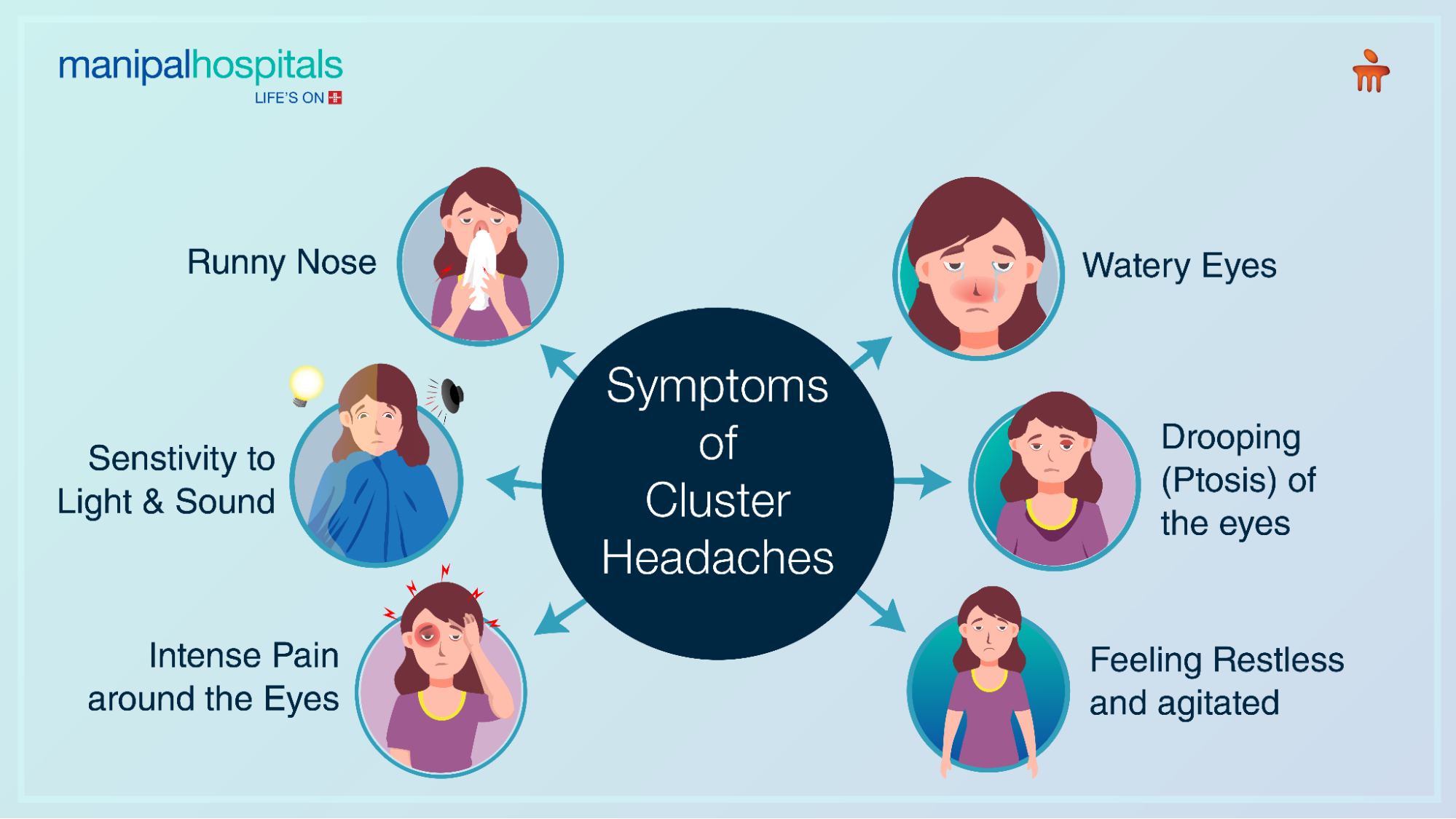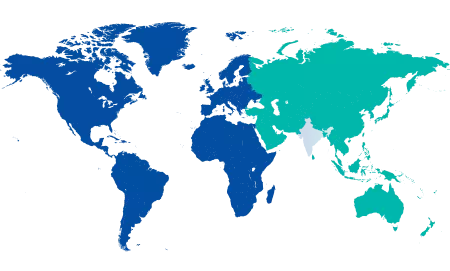
A headache is a nearly universal human experience. Sometimes, it manifests as a migraine, with its relentless throbbing on one or both sides of the head. It might also present as a constricting band of pain, characteristic of tension headaches, or localise to the neck and back of the head, as seen with cervicogenic headaches. However, there is a rarer type of headache, confined to the area around the eye, causing a watery eye and a stuffy nose. This distinct and painful neurological condition, known as a cluster headache, gets its name from the way it arrives in intense bursts, clustered together over weeks or months, followed by a period of remission.
Synopsis
What are Cluster Headaches?
Cluster headaches are intense, recurring headaches that happen in cyclical patterns or clusters. These clusters can last for weeks or months, followed by remission periods that may extend for months or even years. During a cluster period, individuals typically experience severe headaches multiple times a day, with each episode lasting between 15 minutes and three hours.
The pain of a cluster headache is often described as sharp, piercing, burning, or throbbing, and it almost always occurs on one side of the head, typically around or behind one eye. This intense pain, localised to the eye area and occurring in distinct cluster periods (often around the same time each day), is what distinguishes cluster headaches and makes them so debilitating.
Signs of Cluster Headaches
Beyond the intense, one-sided head pain, several other symptoms commonly accompany cluster headaches:
-
Eye-related symptoms: A hallmark of cluster headaches, this often includes a watery eye (lacrimation), redness of the eye (conjunctival injection), and drooping or swelling of the eyelid (ptosis or oedema) on the affected side.
-
Nasal symptoms: A stuffy or runny nose (nasal congestion or rhinorrhea) on the same side as the headache is common.
-
Facial symptoms: Sweating of the forehead or face (facial sweating) and a smaller pupil (miosis) on the affected side can occur.
-
Restlessness and agitation: Unlike migraine sufferers who often seek stillness in a dark room, individuals experiencing a cluster headache are frequently restless and agitated, pacing or rocking in an attempt to find relief.
-
Sensitivity to light and sound (photophobia and phonophobia): While these can occur, they are typically less prominent than migraines and are usually localised to the affected side.
The timing of attacks can also be a significant indicator. Cluster headaches often strike at the same time each day, and nocturnal attacks are common, even waking individuals from sleep.

Cluster Headaches vs. Migraines: Key Differences
While often confused with migraines due to their severity, cluster headaches possess unique characteristics and differ in several crucial aspects:
|
Feature |
Cluster Headache |
Migraine |
|
Pain Location |
Primarily around one eye, temple, and forehead |
Often on one side of the head, but can be on both sides |
|
Pain Description |
Intense, sharp, piercing, burning, or throbbing |
Throbbing, pounding, or pulsating |
|
Duration |
15 minutes to 3 hours |
4 to 72 hours (untreated) |
|
Frequency |
One to several attacks per day during cluster periods |
Variable; can be infrequent or several times per month |
|
Accompanying Symptoms |
Watery eye, red eye, stuffy/runny nose, facial sweating, restlessness |
Nausea, vomiting, sensitivity to light and sound |
|
Behaviour During Attack |
Restlessness, agitation, pacing |
Preferring to lie still in a dark, quiet room |
|
Triggers |
Less clearly defined, alcohol and smoking can be triggers during cluster periods. |
Hormonal changes, stress, certain foods and drinks, and environmental changes |
Reasons for Cluster Headaches
The exact reasons for cluster headaches remain incompletely understood. However, scientists find that the hypothalamus is involved, which is the part of the brain that primarily controls the body’s biological clock. This could also explain why cluster headaches often occur at the same time every day during the cluster period. Some triggers also affect the trigeminal nerve pathway and blood vessels in the face, causing inflammation and pain. Moreover, if the person has a family history of cluster headaches, it increases the likelihood of getting the neurological condition.
Unlike migraines, they are not typically linked to common dietary or environmental triggers, although alcohol and smoking can sometimes trigger attacks during a cluster period.
Remedies for Cluster Headaches
Managing cluster headaches involves two main approaches: abortive treatments to stop an attack in progress and preventative treatments to reduce the frequency and severity of future attacks.
Abortive Treatments:
-
High-flow oxygen therapy: Inhaling 100% oxygen through a non-rebreather mask for 15-20 minutes is often highly effective in aborting an attack.
-
Triptans: Injectable or nasal spray forms of triptans (medications also used for migraines) can provide rapid relief for some individuals.
Preventative Treatments:
-
Calcium channel blockers are often the first-line preventative medication.
-
Doctors may sometimes suggest short-term use of corticosteroids for prevention to break a cluster cycle.
-
Occipital nerve stimulation involves implanting a device to send electrical impulses to the occipital nerves at the back of the head to prevent the onset.
-
Research into new treatments, including CGRP inhibitors (also used for migraine prevention), is ongoing and shows promise.
Conclusion
Living with cluster headache disease can be incredibly challenging, as these debilitating headaches can significantly affect daily life, work, and relationships. However, with the right management plan, individuals with cluster headaches can find ways to reduce the frequency and severity of attacks and improve their quality of life. It is important to seek medical attention if you are experiencing cluster headaches. If you suspect you have cluster headaches, our expert neurosurgeons at Manipal Hospitals, Goa, are ready to help by creating appropriate therapies to manage these headaches.
FAQ's
The exact causes of cluster headaches are not fully understood, but research suggests involvement of the brain's hypothalamus, nerve pathways in the face (trigeminal nerve), and blood vessels. Genetic predisposition may also play a role.
Individual cluster headaches typically last between 15 minutes and three hours if untreated. However, these attacks occur in clusters that can persist for weeks or months.
While maintaining a regular sleep schedule is generally recommended for overall health, sleep doesn't typically resolve an active cluster headache. Nocturnal attacks are common and can even wake people from sleep.
Cluster headaches involve intense, sharp pain typically around one eye, often accompanied by restlessness and nasal/eye symptoms on the affected side, with attacks lasting 15 minutes to 3 hours in clusters. Migraines usually cause throbbing pain, often on one side but can be both, are associated with nausea and light/sound sensitivity, and last 4 to 72 hours.
There's no definitive way to completely avoid cluster headaches, as the exact causes are unknown. However, during a cluster period, avoiding known triggers like alcohol and smoking might help reduce the frequency of attacks for some individuals. Preventive medications prescribed by a doctor are the primary strategy for managing cluster headache cycles.





















 6 Min Read
6 Min Read

















